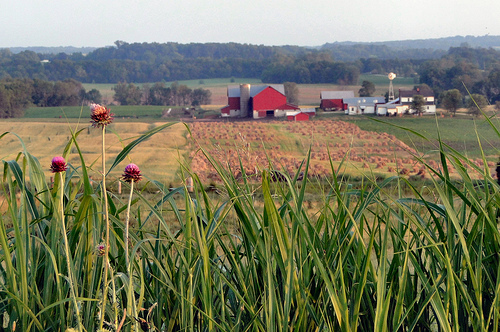Author’s Note:
Friends, if you enjoy writing and would like to hone your skills, consider applying for a Collegeville Institute fall writing workshop. They are small (12 participants), and Collegeville provides tuition, room, and board. I (Patricia Tull) will be leading the Louisville workshop, and Kyle Kramer, discussed below, will join us for conversation.
I’m sure I’m not alone in this: in the growing season, working the vegetable garden, I find Jesus’ parables echoing through my mind. Our seeds take root in receptive, healthy soil; weeds inevitably threaten desirable plants; a gigantic shrub that shelters our garden also shelters the many birds whose singing we enjoy (even as they steal the fruit of our labor). Keeping a garden brings delight, but it also bring much theological insight.
My favorite gardener is Kyle Kramer. After earning his M.Div. at Candler, Kyle decided to move home to southern Indiana and find a plot of land. He had little to go on but his own drive, ideals, and sense of vocation, supplemented by encouragement from his college professor Scott Russell Sanders and Sanders’ friend Wendell Berry. Kyle discovered a badly neglected, hilly farm between Evanston and the Benedictine Monastery of Saint Meinrad (where he also found a day job), and set out to improve the land.
Had I not come across his beautifully — and honestly — written memoir A Time to Plant: Life Lessons in Work, Prayer, and Dirt,I never would have met Kyle. There he describes his vision as “living on a small farm; growing healthy food and stewarding the land well; building an energy-efficient, ‘green’ home; and investing myself in the needs and gifts of the local community.”
He continues: “I felt a deep conviction that this vision was not only what I imagined for my life, but what God was imagining for it as well: a true vocation to which I was called to be faithful” (33). He started by building a pole barn, and in the course of time married a woman loving enough to camp out in the barn with him. Now they live with three children in a home they built with their own hands, a home powered by the sun, surrounded by increasingly verdant fields.
We visited the Kramers one evening last fall. I not only gained admiration for the exuberance and faith with which they lean into their work, and for the joyful creativity of their children, and for their impressive home and projects — the latest being permaculture fruit development. I also saw, both in farming and in writing, what grace looks like for the trusting — what it means to accept failure as intrinsic to life’s program, to learn from mistakes, to accept help, to persist. Grace is always easier to spot in lives that aren’t your own.
As Jesus’ parables and Hebrew Bible’s poetry demonstrate, Scripture was born in a farming landscape where food production was essential, a world dependent on the seasons, the sun, and the rain. Students and pastors I take to the Holy Land say they read the Bible differently after witnessing the landscape of its origins. I believe there is even more scriptural insight to gain from working the soil from which we were formed. The more modern readers dig in the ground, the more we dig into Scripture as well.
Jesus’ parables provide wonderful starting points in July for considering our vocation to till and tend the earth:
Matthew 11:16-19, 25-30 (July 6) highlights the foolishness of a hypercritical generation, never happy with their potential leaders, but also voices Jesus’ much-loved welcome to the weary and heavy-burdened.
Matthew 13:1-9, 18-23 (July 13) relates Jesus’ parable of the seed sown on the path, the rocky ground, the thorns, and the good soil, offering a gardening lesson as well as wisdom for preachers.
Matthew 13:24-30, 36-43 (July 20) tells Jesus’ parable of the weeds sown among the wheat, reminding readers of the good quality of seed that God sows.
Matthew 13:31-33, 44-52 (July 27) relates the parable of the mustard seed, whose tree offers shelter for the birds, and the parables of the treasure hidden in the field and the pearl of great price, reminding readers that what is priceless can be found through single-minded commitment.
Much of the July lectionary’s poetry also shimmers with imagery drawn from the natural world:
Song of Solomon 2:8-13 (July 6) describes young love in a spring pastoral setting: gazelles, flowers, turtledoves, fig trees fruiting, vines blossoming.
Psalm 145:8-14 (July 6) describes God’s mercy toward all creation.
Isaiah 55:10-13 (July 13) imagines the word of God as rain and snow that water the earth, giving it fruitfulness; the mountains, hills, and trees rejoicing; and the cypress and myrtle flourishing.
Psalm 65: (1-8), 9-13 (July 13) describes God’s founding of the mountains, silencing of the seas, enriching the earth with rain for field crops, so that pastures overflow and the earth’s farthest horizons shout for joy.
Psalm 139:1-12, 23-24 (July 20) celebrates God’s omnipresence throughout the earth: above in heaven, below in Sheol, beyond the sea, in night, in day.
Psalm 128 (July 27) describes prosperity in terms of eating one’s own harvest, and compares family members to fruitful vines and olive shoots.
The Romans passages for July 6 and 13 (Romans 7:15-25a and 8:1-11) offer some challenges. The flesh/spirit dichotomy Paul presents there, in which the will of the flesh leads to evil and death, but the Spirit is associated with life and peace, may be mistaken as denying earthly life’s value. Yet the distinction being made is not between the body and the soul, nor between earth and heaven, nor between this life and the next, but between wise, spirit-guided choices and foolish, short-sighted ones.
The Romans passages for July 20 and 27 (Romans 8:12-25 and 8:26-39) underscore creation’s involvement in this project of spiritual flourishing: “For the creation waits with eager longing for the revealing of the children of God … the creation itself will be set free from its bondage to decay.” Nothing in creation, Paul says, stands between us and God’s love. In fact, it’s through creation that we know God.

